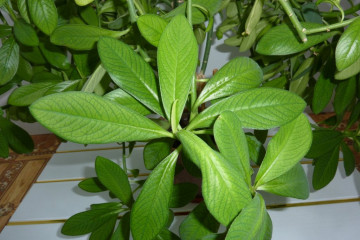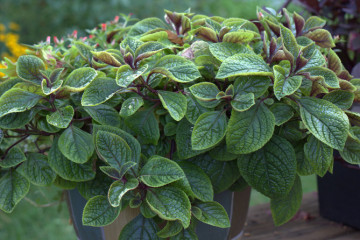Dizigoteka: home care and main varieties
Content:
Dizygotheca (Dizygotheca) is not a common houseplant, so it can only be found in avid flower growers. This is due to the fact that if the growing conditions do not match, the plant dies. Despite the fact that the dizigoteka flower is in many ways similar to the cheflera, it needs special care, unlike the latter. Therefore, before you start this plant at home, you need to familiarize yourself with its preferences so that later there are no problems.
Main types
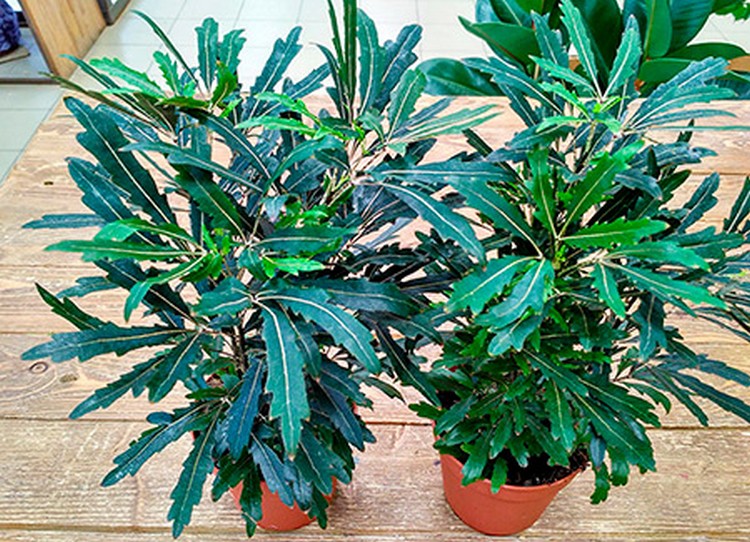
Dizigoteka - a flower with a capricious character
Most often, only one type of dizigotec can be found on sale, namely elegantissima, although there are about 17 of them in nature. The difference lies in the shape of the leaves and color. They can grow as a small tree or shrub. Therefore, you should familiarize yourself with the varieties of this plant and how they differ.
Dizigoteka Elegantissima
This species in a house or apartment grows no more than 2 m, although in nature it reaches 8 m. It has erect, flexible shoots. The leaves consist of 7 to 10 divided segments. The length of each reaches 30 cm, and the width is about 2 cm. The plates have a thyroid, rounded shape. They are attached to the shoots with the help of long petioles. The color of the leaves is contrasting, light streaks stand out against a dark green background. Dizigoteca Elegantissima blooms in late August and early September. Her flowers are not particularly decorative. Their diameter is 1.0-1.5 cm, the color of the petals is white-green.
Dizigoteka Bianca
An ornamental plant variety derived from the previous species. Forms a shrub no more than 1.2 m high. Shoots are erect, flexible. The leaves consist of short segments no more than 10 cm long and 1.0-1.5 cm wide. The main tone of the plates is dark green, but along the edge there is a white edging. The veins on the leaves of the Bianca dizigotec are purple.
Graceful
This species is characterized by erect shoots reaching a height of 2 m. Finger-compound leaves are attached to them with petioles, each of which consists of 7-10 separate segments. Dizygoteka graceful is characterized by a dark green, almost black shade of plates, along the edge of which there is a pronounced serration. The stems of the plant become lignified as they grow and are covered with brown, rough bark.
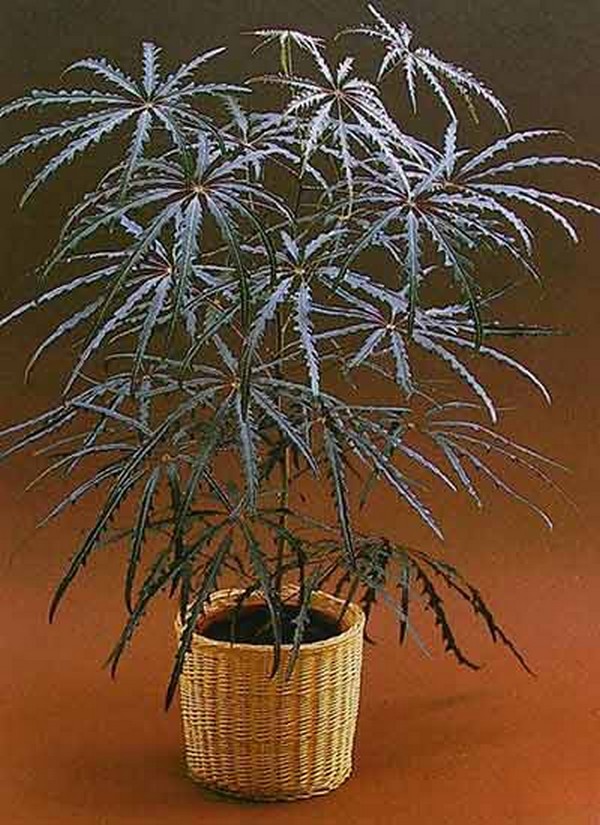
Dizigoteka graceful
Other
It is very rare to find Veich's dizygotek on sale. The plant resembles an elegant variety in appearance. But her leaves are wider and slightly wavy around the edge.
You can also find the Castor dizygotek. It is distinguished by short leaf lobes, along the edge of which there are rounded teeth. The color of the plates is dark, but the veins are light.
There is also an ornamental variety of the Gemini plant. Its distinctive feature is the ovoid shape of the leaves. They consist of 3-5 segments with a coarse serrated edge. The color of the leaves is dark green.
Dizigoteka: home care
In order for this culture with graceful leaves to grow and develop, it needs to provide favorable conditions.To do this, you need to study the basic requirements of the plant. Otherwise, the dizygoteka will not only look dejected, but it may also die.
Watering
Dizigoteka poorly tolerates excess and lack of moisture in the soil. Therefore, it should be watered sparingly as the top layer of the soil in the pot dries out. For this, it is necessary to use settled water at room temperature. In summer, dizygotek should be watered more often, and less often in winter.
Temperature
Home care includes creating an optimal temperature regime for keeping. This plant belongs to the thermophilic category. The optimal temperature for it is + 18-28 degrees. When it decreases, the leaves of the plant may fall off.
Humidity
The dizigoteca plant needs high air humidity. Therefore, its crown must be sprayed regularly with warm water. In hot periods of the year, measures should be taken to maintain favorable conditions, therefore it is recommended to install containers with water next to the pot.
Pruning
Dizygotek care includes pruning. As the plant grows, it gets rid of the lower leaves, and its crown rushes up. Therefore, every spring it is necessary to shorten the shoots of the dizigoteca, which will increase its bushiness and decorative effect. Without pruning, the plant looks like a palm tree.
Lighting
For the full development of dizygotek at home, bright diffused light is needed. The best option may be the eastern window, where the sun's rays appear in the morning. When growing a dizigoteca on the south or west window, burns may appear on the leaves of the plant, so light shading is required.
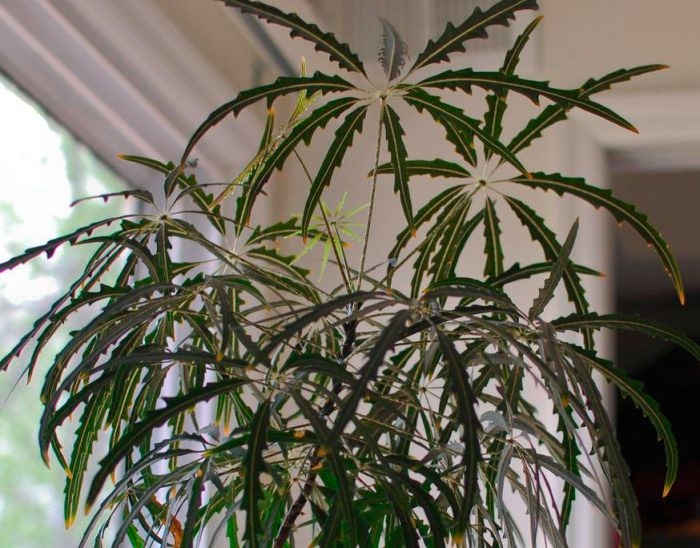
On the north side, the plant may lack light, which will lead to leaf fall
In winter, it is necessary to provide the plant with twelve hours of daylight. Therefore, in the evening, it is recommended to use lamps, placing them at a height of 30 cm above the flower.
Plant transplant
A young plant needs to be replanted every 2-3 years. The soil for this must be purchased in the store. For a dizigoteca, the same substrate is suitable as for alocasia or dracaena, but it must have good moisture and air permeability. Transplanting should be carried out by the transshipment method. In this case, you can slightly remove the old soil from the roots. The pot should be chosen 2 cm wider and deeper than the previous one.
Procedure:
- Lay a layer of expanded clay with a thickness of 1.5-2 cm at the bottom.
- Sprinkle it with substrate on top.
- Carefully remove the dizygotek from the previous pot, remove some soil from the roots.
- Place the plant in the center without deepening the root collar.
- Fill the resulting voids with a nutrient substrate.
- Compact the surface, water.
For the next 2-3 days, the plant must be kept in a shaded place so that it can recover. And then return to the windowsill.
Breeding options
According to the description, this houseplant can be propagated by seeds and cuttings. Each of these methods has its own characteristics.
Seeds
This method is quite laborious, but it allows you to get a lot of seedlings. Sowing should be done in late February or early March. To do this, you need to use wide containers with a height of 10 cm. It is better to plant dizigoteka seeds in a moist substrate to a depth of 0.5 cm. After that, the container should be covered with foil and rearranged to a warm place with a temperature of +24 degrees.Bottom heating helps to speed up germination.
The first shoots should appear in 3 weeks. After that, the container must be rearranged to the window and the temperature of the content must be reduced to + 20-22 degrees. When 2-3 true leaves appear, the seedlings should be dived, and when they grow up, transplanted into pots.
Cuttings
This method is recommended to be used immediately after pruning the plant. To do this, it is necessary to prepare the apical cuttings 7-10 cm long. At the bottom, they need to be cleaned of leaves, and then the lower cut should be powdered with any root former. They should be planted in a mixture of peat and sand, taken in equal volume, or in peat tablets.
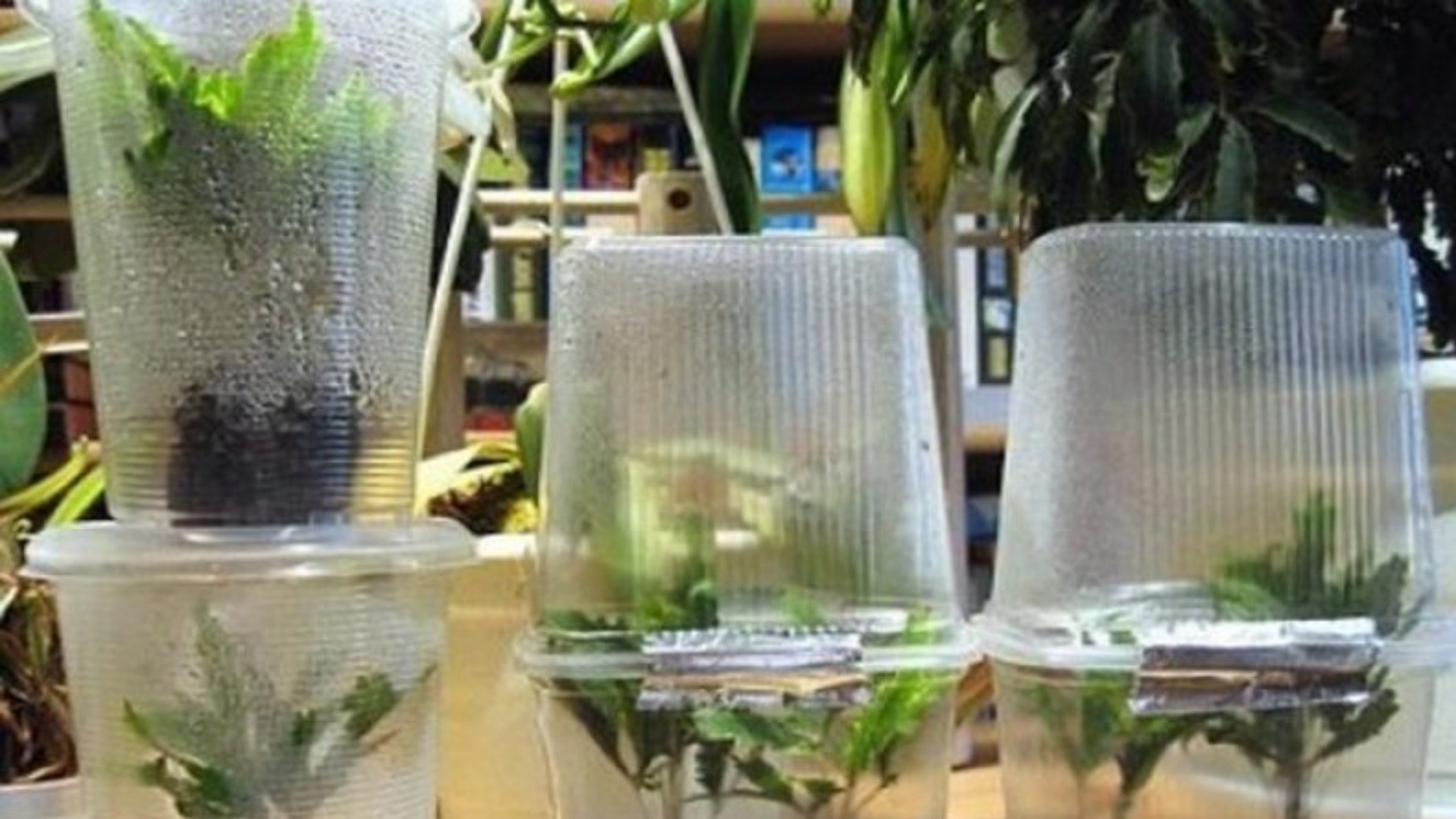
Dizogoteka cuttings root poorly
To create favorable conditions, the cuttings should be covered with a transparent cap, provide good lighting and a temperature within + 22-24 degrees. The greenhouse should be ventilated every day, humidification should be carried out when the top layer of the soil dries up. Dizigoteca cuttings take root in 1.5-2 months. When they get stronger and grow, they can be transplanted into pots.
Dizigoteka is an ornamental deciduous plant that can beautify a home if properly cared for. However, before you buy it, you need to really assess your capabilities. After all, any mistake in care can lead to the death of the flower.


